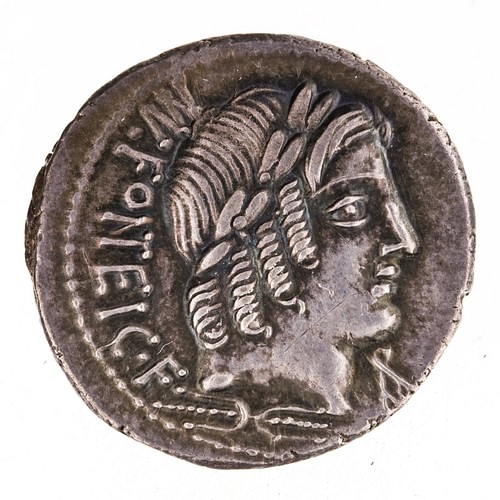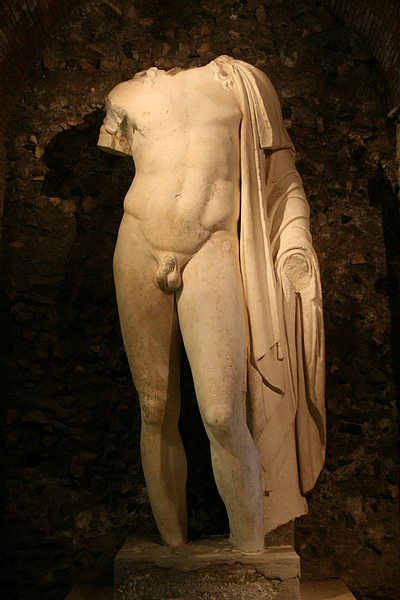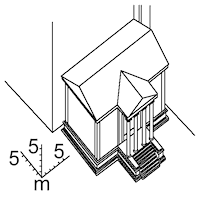
Vejovis (sometimes spelt Vediovis) was an obscure Roman deity. He is poorly attested in both written sources and archaeology, and his nature is debated by scholars. His name is related to Jove (Jupiter), and some authors described him as either a 'little Jupiter' or 'anti-Jupiter.' Others have implied an association with the underworld. He was celebrated with festivals on 1 January, 7 March, and 21 May, but the nature of these festivals, as with the rest of the god's cult, is unknown.
His worship dated to the very earliest period of Roman history, when his cult was introduced to Rome by the Sabine king Titus Tatius. Other scholars suggest a relation to the Etruscan deity Veive, which is supported by references to Vejovis in an Etruscan divination formula, preserved by Martianus Capella, which places him among gods of thunder and lightning.
Vejovis had already fallen into obscurity by the 1st century BCE, and Roman authors offered several explanations for the meaning of his name and the nature of his powers. Ovid describes him as being depicted as a young Jupiter carrying no thunderbolts, accompanied by a female goat. The 2nd century CE Latin author Gellius, on the other hand, depicts him as a negative force, the reverse of Jupiter, who was worshipped to pacify his wrath, rather than to seek his aid. He describes Vejovis as being depicted holding a bundle of arrows, which he used to inflict harm, and was propitiated with the sacrifice of a female goat 'ritu humano,' on behalf of or in place of a human. Gellius also notes that some equated Vejovis with Apollo on account of their similar appearance.
…the statue of the god Vediovis… holds arrows, which, clearly, are meant to inflict harm.
(Gellius, Noctes Attica, Book V, 12.11-12)
Vejovis was often invoked during times of war. One such invocation is preserved in Macrobius' 5th century CE Saturnalia which was used by dictators or generals to devote enemy cities and armies to destruction. This invocation clearly draws upon Vejovis' destructive aspects:
Father Dis, Veiovis, Manes, or by whatever other name it is right to call you: may you all fill that city of Carthage, and that army of which it is my intention to speak, and those who will bear arms and missiles against our legions and armies, with the urge to flee, with dread, with panic; and may you lead away that army, that enemy… deprive them of heaven's light… may you consider [their] cities and fields and the people's lives and lifetimes cursed…
(Macrobius, Saturnalia, Book 3, 9.10-12)
Elsewhere, Livy noted that L. Furius Purpureo had called upon Vejovis, apparently successfully, to route the Gauls at the Battle of Cremona in 200 BCE.
In terms of depictions of Vejovis, Pliny the Elder described the preservation of a wooden statue of Vejovis which had been consecrated along with the temple in 192 BCE. The remains of a marble statue depicting a youthful body with long, flowing hair, but missing the head, was recovered from the Temple of Vejovis on Rome's Capitoline Hill. Additionally, some scholars interpret a series of first century BCE denarii coins as representing Vejovis, while others reject this identification, instead identifying the deity depicted as Apollo.
There were two temples dedicated to Vejovis in Rome: one between the two summits of the Capitoline Hill (the one referenced by Pliny), and another on Tiber Island. The construction of the temple of Tiber Island was vowed by the praetor L. Furius Purpureo as noted above, and the second temple was vowed by him during his later consulship. The work done to the Capitoline temple may have been a restoration of an earlier structure, as Ovid implies it had existed since the time of Romulus, and was a place of refuge. The consecration of that temple was celebrated on the Nones of March (March 7).
The Capitoline temple was restored by Emperor Domitian in the late 1st century CE, and excavated in 1939 CE. It was unique in its construction, oriented horizontally (left to right) so as to fit into the limited space available in the area. An inscribed altar dedicated to Vejovis by the gens Iulia, the family of Julius Caesar and Emperor Augustus, was found at Bovillae, dedicated according to the 'Alban law,' yet another term of obscure meaning.








